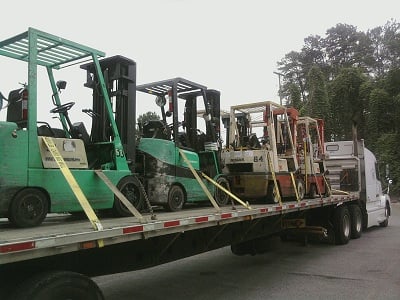REDWOOD LOGIN
Redwood PortalLTL
SCS
SCS Support
Rockfarm
Forklifts are often times a warehouse manager’s best friend. They allow the swift and efficient transportation of bulky/heavy objects throughout the warehouse or distribution center. As great as forklifts are for product management, the shipping of the machines can be quite the headache. This article addresses some of the issues inherent in forklift shipping as well as best practices to consider.
The most prevalent issue of forklift shipping is the relatively low demand for associated shipping services. This trend has the effect of increased prices for forklift transportation. Additionally, because most forklift shipping is done via a flatbed carrier (more on that in the next section) and flatbed prices tend to be high, the cost expense can be greater than expected. The low demand for forklift shipping can also make carrier selection more difficult. There are relatively fewer carriers dedicated to forklift shipping. For example, demand for automobile shipping is very high. This high demand translates into greater amounts of dedicated automobile carriers which drive down prices and increase shipping availability. Because forklift shipping does not benefit from high levels of demand, prices are more expensive and shipping availability decreases.
So now that we have a solid understanding of the issues associated with forklift shipping, let's now get into some of the best practices to consider. Compared to other heavy machinery, forklifts have the benefit of being relatively compact in size. Because forklifts are designed to navigate the narrow alleys of many warehouses they are comparatively easier to pack onto a trailer than other pieces of heavy machinery such as a tractor or some type of construction equipment. This allows for more flexibility in shipment sizes. So now the question is what method of shipping should be used for forklifts? For the purposes of this article, we will focus on LTL and Flatbed.

LTL is a great choice for shippers when looking to mitigate costs and increase the flexibility of shipment sizes. The problem that LTL faces, regarding forklift shipping, is space. Forklifts, despite their compact size, compared to other pieces of heavy machinery are still relatively bulky. This limits the number of forklifts that can be shipped per truck. However, if you are looking to ship a small number of forklifts and want to save on costs than LTL may be the perfect option for you.
Flatbeds, on the other hand, are the more traditional choice for forklift shipping. Flatbed shippers, while usually more expensive, can handle larger numbers of forklifts per shipment. Which is great for people looking to transport larger amounts of forklifts. When deciding whether to use LTL or flatbed, much of the final decision comes down to the number of forklifts needing shipping. When making your decision, take the time to analyze your needs and priorities. This can help lead to improved decision making and strategy. If you are unsure in your analysis than consulting with a reputable 3PL such as LTX can be a great way to acquire valuable expertise and advice. Your peace of mind is the primary objective at LTX and we would be more than happy to address all your shipping concerns.
Shipping forklifts is not a very common service in the transportation industry, but it can quickly turn into a costly endeavor for the ill-informed. The biggest factor to consider is the method of shipping that is optimal for transporting forklifts. LTL and flatbed are two good options to consider. Both have their pros and cons, but the choice between the two largely depends on the number of forklifts in the shipment. If you are unsure of which method to utilize than feel free to contact LTX with any questions you may have. LTX has over 100 years of combined experience in the transportation industry and we have both the technology and expertise to address any questions or concerns you may have.